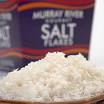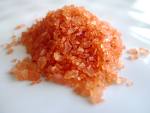Last week, The Lady paired Moonstruck Chocolates with some of her sea salts and I reviewed them here although I wasn’t allowed to partake of those luscious morsels of cocoa and sugar… “Don’t want the baby boy to get a tummy ache”… what a crock… The Lady and The Man didn’t want to share… shame on them…
What I failed to mention in that blog post is that The Lady has quietly been building a salt cellar in the kitchen at the manse, grain by grain. Those who know her know she does nothing half-heartedly; moderation doesn’t exist in her life. In The Lady’s world, if it’s worth doing… then you do it well and with total abandon… and as it turns out, salt would be no exception… the things The Man tolerates… the things I tolerate…
On the counter above the olive bar at The Lady’s kiosk, is the specialty sea salts display that The Lady sells. There are a total of twelve and The Lady has purchased small containers of each of them. Now a salt shaker of Himalayan Pink graces the dining table; Cyprus White Flake and Murray River Flake sit on the cutting board where she prepares meals and a spice rack sitting next to the stove-top contains the rest.
Here’s what I have learned as The Lady “schools” The Man on the virtues of each salt:
Himalayan Pink: 
This is now our “everyday” table salt.
Himalayan Pink, as the name implies, is a lovely pale-to-vivid pink that is mined by hand from ancient dried lakebeds, covered by volcanic lava, high in the Himalayans. This is a fossilized marine salt high in minerals and pure; nothing is added to this salt. In fact, in salt “circles”, Himalayan Pink is considered the purest salt on earth. What you see is what you get… and that’s a good thing. In addition to selling it in grain form for easy use, The Lady also sells it in rectangular and round blocks which can be used for cooking, serving and as décor.
To cook using a Himalayan Pink slab, you pre-heat your oven to 500° and heat the salt slab for 30 minutes. When you take it out of the oven, add a little EVOO to the top of the slab and sauté your thinly sliced veggies and meat. They take on a bit of the saltiness of the slab and sauté to perfection. When it cools, wipe it off with a clean, dry cloth and it’s good to go again… and again.
Himalayan Pink can also be used in the bath because it is naturally rich in more than 80 nourishing and skin-replenishing minerals. The Lady says that she has many customers purchase up to a pound at a time to be used for therapeutic reasons; claiming this salt soothes sore muscles, aids in digestion (reducing acid), lowers blood pressure and helps remove toxins from the body.
 Murray River Flake:
Murray River Flake:
Peach is a favorite color (and fruit) of The Lady’s so it is natural that she would like Murray River Flake. It is a delicate peach color and light with a mild flavor. It melts quickly and evenly making it ideal as a salt to use in cooking and finishing.
The waters of the Murray River of Australia, one of the largest on the continent, come from the snow of the Australian Alps. Salt is a natural feature there and the water settles in the Murray-Darling Basin which has low rainfall and a high evaporation rate. This is ideal for concentrating salt in the groundwater. This salt is produced naturally from the brine of the river and takes its color from the beta carotene secreted from the algae. The underground waters have been dormant for eons and from them this salt is produced.
Cyprus Flake:
The Lady claims this is a favorite of chefs. This salt is a bright white, shaped in pyramids and holds its crunch when used as a finishing salt. This salt tastes like the Mediterranean Sea around the island of Cyprus; you can smell the sweet, salt air when you let a flake melt on your tongue. You use less of this salt as it holds its shape when sitting atop food making its finish quite satisfying.
 Fleur de Sel:
Fleur de Sel:
Many consider this the best of all sea salts. It is hand-harvested in salt pans as the sea water evaporates. Often the name will also include the area where it is harvested such as Fleur de Sel de Guerande which is harvested on the Guerande Peninsula of France. This salt is absolutely delicious with chocolate. Although, I personally would not be able to confirm this because of the selfishness of The Lady when it comes to sharing her chocolate… but I bitch and digress…
Bit of trivia: Only the top layer from these salt pans becomes Fleur de Sel as it is the purest. The layers below become Sel Gris, another salt that The Lady has in her salt rack. For every 80 kilos of Sel Gris (which means “grey salt”) only 1 kilo of Fleur de Sel is produced. As you might expect, Fleur de Sel is one of the more expensive of the salts The Lady sells. (It is three times the cost of Sel Gris.)
Sel Gris:
As mentioned above, this sea salt is grey in color; almost a dingy grey. It is the third most popular of the salts The Lady sells. France is the leading producer of Sel Gris but (surprise!), China is now producing Sel Gris. Italy also produces a respectable Sel Gris. It has an almost briny taste and is great on preparing and serving fish.
 Hawaiian Alaea:
Hawaiian Alaea:
This salt is a deep red color and is harvested on the Hawaiian Island of Molokai. The coarse grains make it pretty and ideal for presentation. It has a hint of sweetness to it and is great for grilling and sprinkled on mild aged cheeses such as Mahon or Chaumes.
A bit of trivia: The Island of Molokai does not have a single traffic light…
Others that The Lady sells include: Bolivian Rose, Hawaiian Black Lava, Mediterranean Fine Grain, Atlantic Coarse Grain and two smoked salts: Fumee de Sel from France and Salish Alderwood from Wahington State.
The Lady also has a Habanero-flavored salt that she purchased at Foster and Dobbs in NE Portland.
For more information, The Lady recommends you visit the Saltworks Sea Salt website, which is the company that supplies her with The Salts she sells.
Also, please check out the cheese, salts and chocolate pairings we recommend by clicking here.
5 thoughts on “The Lady's New Mania: Sea Salts”
Comments are closed.

Really interesting post. How do you use the pea size crystals other than decoration?
None of the salt grains are that big, actually. Not sure which you are referring to.